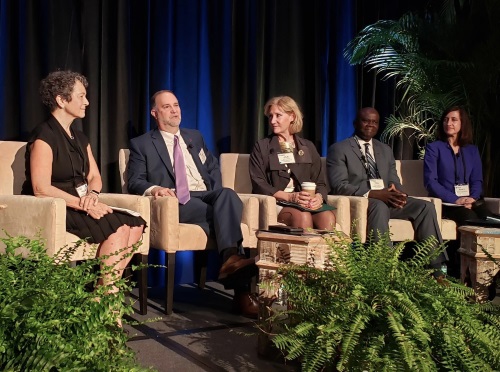A panel of state department of transportation leaders at the American Association of State Highway and Transportation Officials annual Washington Briefing on February 27 outlined why formula funding – used to disburse federal motor vehicle tax revenues to the states – remains critical to sustaining and enhancing the nation’s transportation network for the future.
[Left to right in above photo: Scott Bennett, Arkansas DOT; Diane Gutierrez-Scaccetti, New Jersey DOT; Bill Panos, North Dakota DOT.]
“Core formula programs are the foundational part of transportation funding,” explained Diane Gutierrez-Scaccetti, commissioner of the New Jersey DOT.
“Is it perfect? No it is not. I would love to see additional flexibility added to it. But the core formula program works,” she stressed. “At the end of the day it is extraordinarily important to get legislators to understand the importance of steady funding. We need federal [funding] plans to match up with state plans in order to give us full confidence going forward that we can execute transportation projects.”

Bill Panos, director of the North Dakota DOT, said that as formula funds can make up to 50 percent of a state’s overall transportation funding “bucket,” it provides a level of ongoing “stability and flexibility” to allow state DOTs to make transportation investments.
“It is an extremely efficient way to deliver projects; ensuring states have certainty they have funds so they can go forward to design and build projects,” he said. “Steady, regular funding from the federal government gives us the ability to plan long-term. I need a long term federal financing strategy to match my long-term state financing strategy. On top of that, having [funding] flexibility is incredibly important to state DOTs – with fewer restrictions – is just a practical matter; not a policy or political statement. It helps us do more, in more ways.”
That illustrates why New Jersey DOT’s Gutierrez-Scaccetti does not believe increasing discretionary grant funding at the expense of formula funding is a wise idea.
“The issue I have with discretionary grants is it takes staff time away to work on compiling grant applications when we have no idea if those [grant] funds will ever come through. That uncertainty concerns me,” she said. “Also, I am not sure competing for dollars with other states is healthy – roads do not stop at state lines, after all. We need more collaborative discussions among us [state DOTs] so we can fix common transportation issues.”



